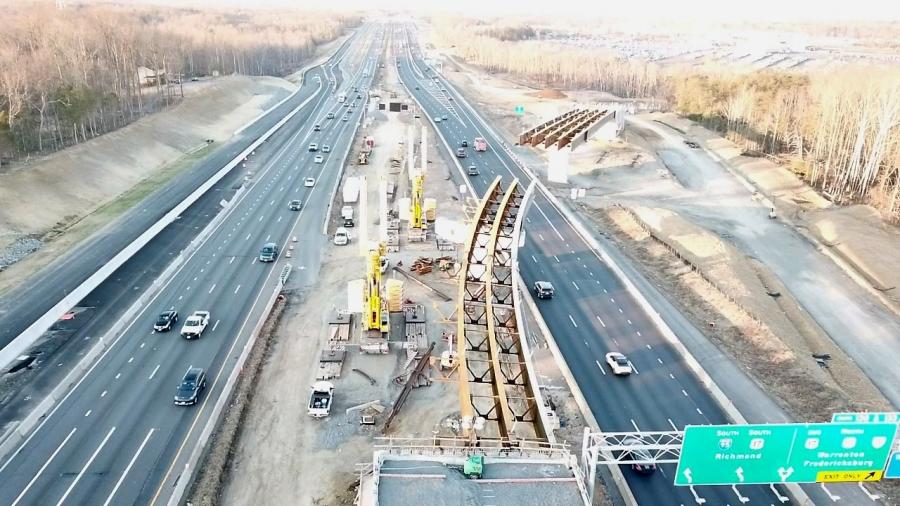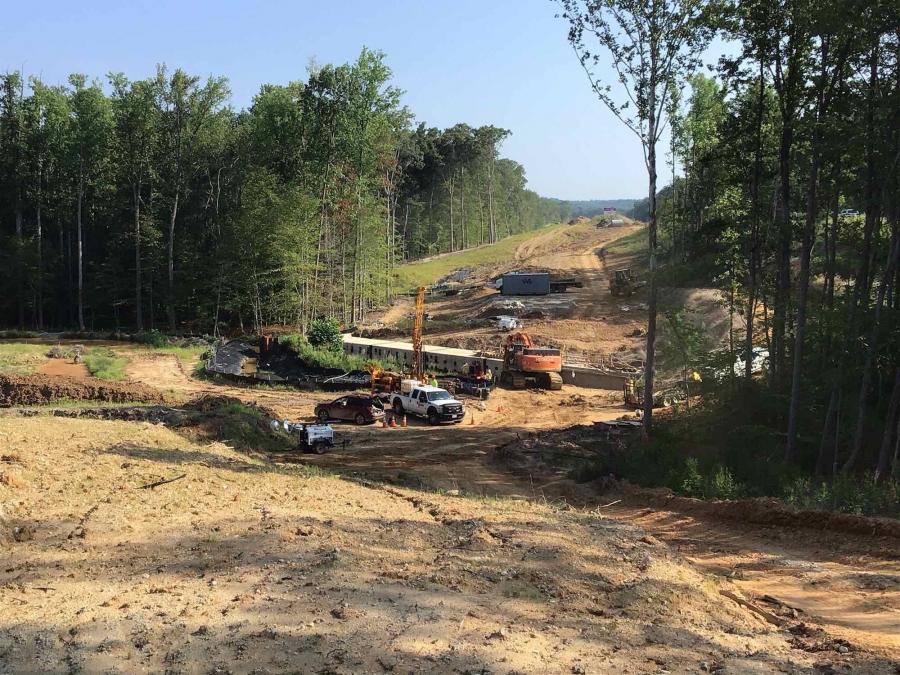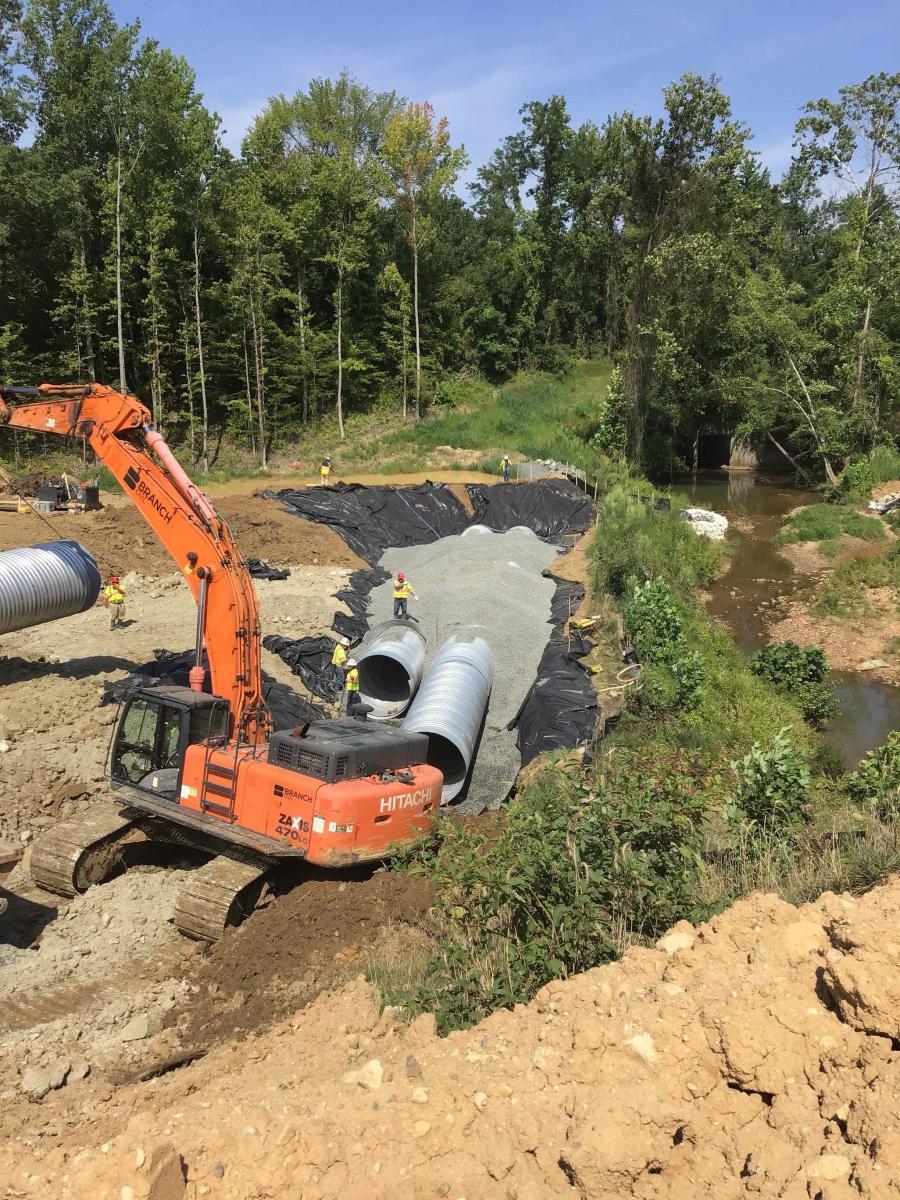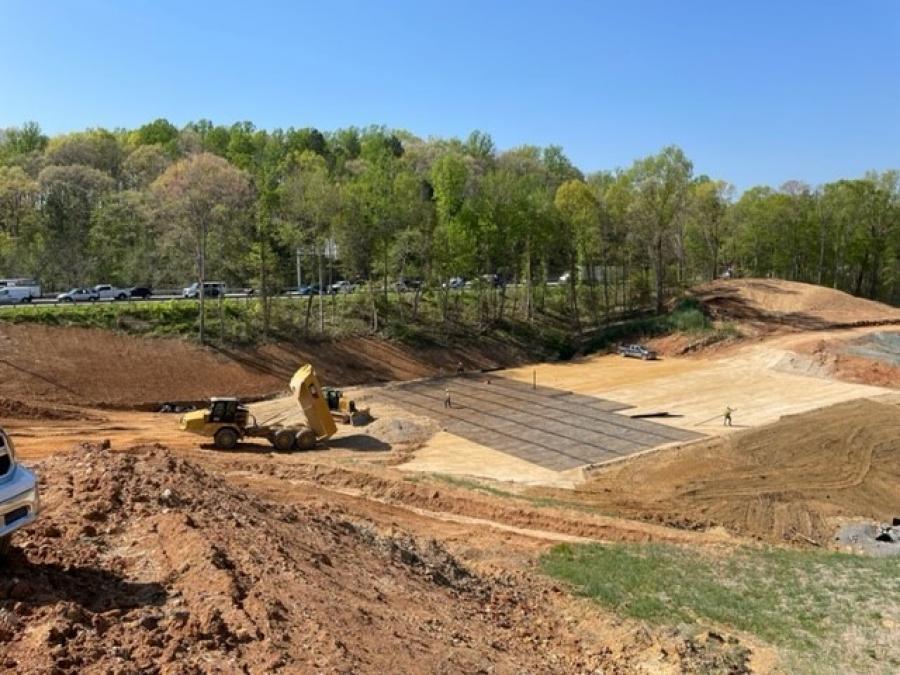Flyover bridge construction was an essential part of building express lanes along I-95 in Virginia.
(Photo courtesy of Branch Civil-Flatiron.)
Over the past 10 years, the Virginia Department of Transportation (VDOT) has presided over a congestion-relief strategy of building networks of high occupancy toll (HOT) lanes that double as free high occupancy vehicle (HOV) lanes.
As part of this strategy, six different HOT lane projects have added express lanes to ease heavy traffic radiating into northern Virginia from Washington D.C. In most cases, vehicles with three or more people, buses and motorcycles can use these express lanes for free. Drivers of other vehicles must pay tolls that vary in amount based on traffic conditions.
Many drivers choose to pay the toll to use the express lanes rather than travel the general purpose lanes at reduced speed. In theory, as more cars use the express lanes normal traffic congestion is reduced and everyone arrives at their destinations earlier.
A public-private partnership between VDOT and Transurban is expanding the network of nearly 100 mi. of HOT lanes in northern Virginia. Transurban, as the concessionaire, is financing and overseeing the expansion, then operating and maintaining the toll lanes for the 50-year life of the tolling agreement. The roads will revert to VDOT when the agreement expires.
The joint venture team of Branch Civil and Flatiron Construction (Branch-Flatiron) was awarded a $291 million design-build contract by Transurban to extend reversible HOT lanes southward from Quantico to Fredericksburg, in the always busy I-95 corridor south of the D.C. beltway. Work on this 10-mi. extension, known as Fred Ex, began in 2019 and is expected to be opened to the public before the end of 2023. The original construction cost of the project is expected to increase approximately $100 million due to problematic soils.
Soil Issues
Durable roads require good subgrade and stable embankments, which can be tough to achieve when soils have high clay contents. Unfortunately, geotechnical investigation at the start of the Fred Ex design-build effort revealed more poor-quality clay than expected, mandating expensive and time-consuming remedies.
Clays can be problematic because they retain moisture and swell. As a result, natural clay deposits tend to settle when roadway embankments are built. Man-made embankments themselves are prone to settlement and failure if they contain clay that is not properly compacted and/or reinforced during the construction process. Proper compaction frequently requires lowering the moisture content (drying) of clays, while a typical reinforcement for embankments containing clay would be incorporating layers of geogrid during placement.
Disposal and replacement of soils with clay is one solution when building embankments. However, it is expensive. Another alternative is to dry the soil by exposure to sun and wind. This option can be extremely time consuming. A common solution contractors employ is to treat clay soils with lime or other chemical additives to dry them out. The problem with this solution is that high concentrations of chemical additives like lime will degrade the geogrid.
The Branch-Flatiron joint venture team faced this grim reality on the Fred Ex project. Natural drying for more than 1.4 million cu. yds. of embankment was probably not going to work due to schedule constraints.
"With all the rainfall we have had over the last two years, it was obvious that drying the clay could not be completed anytime soon," said Brian Quinlan, president of Branch Civil.
Whatever could not be dried in a timely fashion had to be removed from the job site and replaced with imported material. As for embankments with underlying clay seams, an extensive and costly regimen of installing densified aggregate piers (DAPs) was required to minimize settlement.
While Transurban and Branch-Flatiron resolved the commercial aspects of dealing with the project soils, VDOT stepped up with a noteworthy solution to help with the cost. Branch-Flatiron was allowed to deposit wasted material at a VDOT site just 15 minutes from the construction site. This saved trucking and landfill "tipping" fees for this material that could run to $30 per cubic yard.
Once the project team settled on a combination of DAPs, natural drying, chemical drying and removal/replacement, work started moving ahead quickly.
Details of Work
The I-95 Fred Ex project extends I-95's reversible express lanes from Mile Marker 148 near Quantico to Mile Marker 134 just north of the Rappahannock River near Fredericksburg. Concurrent with Transurban's Fred Ex project, VDOT contracted directly with Wagman to build new parallel bridges across the Rappahannock, effectively doubling capacity at the river crossing and eliminating a major choke point on the I-95 corridor.
Coordination between contractors Branch-Flatiron and Wagman on the project has been crucial. For instance, Branch-Flatiron is accelerating delivery of a new ramp to accommodate traffic sequencing requirements on the Wagman project.
"The express lanes we are building will be connected to the Wagman job at the new Rappahannock bridges by a couple of new flyovers," said Quinlan. "The result should be major improvements for both northbound and southbound traffic, with further improvements coming from two other flyovers we are building at the north end of our project for Quantico traffic."
Quinlan expects three of the flyovers to be completed this year and the fourth to be completed early in 2023, so all will be in place when the express lane extension is opened.
Fred Ex also includes a new simple span bridge to carry the express lanes over Potomac Creek and replacement bridges to carry local traffic on Truslow Road and American Legion Road over I-95. The Truslow bridge was rebuilt early in the project, while work replacing the American Legion is ongoing. Work on the bridge at Potomac Creek is expected to be completed this year. The joint venture is self-performing pile driving and concrete work for the bridges.
As is typical for a roadway project, the quantity of pavement and construction aggregates was significant. Superior Paving will furnish and place approximately 350,000 tons of asphalt. Luck Stone is providing the construction aggregates as well as some 150,000 tons of pit fines that will be imported to replace wasted clay soils.
A HOT lane project is not just another roadway job because it also has an unusually large electrical component. In fact, the largest subcontractor for the project is Aldridge Electric. In addition to lighting, overhead sign and other electrical work, Aldridge is responsible for the ITS infrastructure and fiberoptic lines for the variable-rate tolling system. Transurban is deploying the EZ Pass system common on East Coast projects.
Transportation officials said that the HOT lane extension through Fredericksburg and associated improvements to the general-purpose lanes will increase lane capacity by 66 percent during peak travel periods along one of the busiest highway sections in America.
Amanda Baxter, vice president of Transurban's Virginia market, said the goal of delivering the project by late 2023 is still on track.
"These megaprojects are very complex," she said. "We went into this year wanting to find a path forward, and we had good dialogue with our contractors on how to advance this project."
"We appreciate having a positive relationship with Transurban and VDOT," said Quinlan. "Transurban, VDOT and Branch-Flatiron are working as a team on this important project, which is essential for timely delivery." CEG
Chuck MacDonald
Chuck MacDonald is an editor, blogger and freelance feature writer whose writing adventures have taken him to 48 states and 10 countries. He has been the editor for magazines on pavement construction, chemicals, insurance and missions. Chuck enjoys bicycling, kayaking and reading. He graduated from the University of Missouri with a degree in journalism. Chuck lives in Annapolis, Md. with his wife Kristen. They have seven grandchildren.
Read more from Chuck MacDonald here.
Today's top stories


















